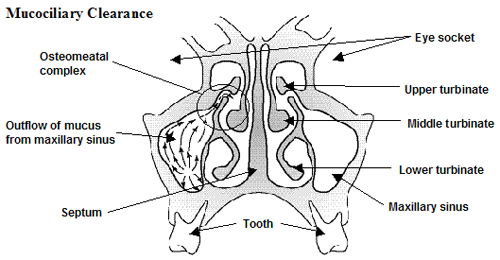Mucociliary Clearance
Mucus and the underlying respiratory mucous membrane protect the sinuses against infection. Mucus cleanses the nose and throat. It flushes out invading microorganisms and pollutants through its constant movement down the upper respiratory tract. Mucus helps moderate the effects of humidity and temperature on the respiratory tract. There are millions of cilia that sweep back and forth on the average of 10 - 20 beats per second pushing the mucus along. Mucociliary clearance clears the sinuses of their secretions in less than 10 minutes. The mucus then drains from the nose to the throat in about 20 - 30 minutes.

Mucus is affected by several factors including:
- Histamine release and other chemicals from allergies (increase mucus production)
- Diseases: for example: cystic fibrosis (increase mucus production)
- Nerve tissue stimulation (increase or decrease mucus production)
- Body hydration, temperature, humidity (increase or decrease mucus production)
- Local blood supply (increase or decrease mucus production)
- Infections (increase mucus production)
- Hormones (usually increase mucus production)
- Tobacco smoke exposure (usually increase mucus production)
- Radiation damage (decrease mucus production)
- Medications
Some common causes of impaired mucociliary clearance are:
- Active and passive tobacco smoke exposure
- Gastroesophageal reflux
- Narrowed nasal passages
- Nasal septal deviation
- Turbinate malformations
- Nasal tumors
- Nasal polyps
- Foreign bodies
- Ciliary defects from beta blockers, viruses, dry environment, sulfur dioxide and genetic defects of cilia
How Do You Test for Mucociliary Clearance?
Decrease in mucociliary clearance can be identified through a clinical test. A drop of saccharine is placed inside your nose. You are instructed not to sniff. You should detect a sweet taste within 5 - 8 minutes if mucociliary clearance is normal. Twelve minutes is considered slow and 25 minutes or longer indicates a defect in mucociliary transport.
A ciliary defect affecting mucociliary clearance can be determined through biopsy of the nasal mucosa. This examination can detect whether there is a structural defect in the ciliary structure. A well known but rare ciliary defect that can be determined by biopsy is immotile cilia syndrome.